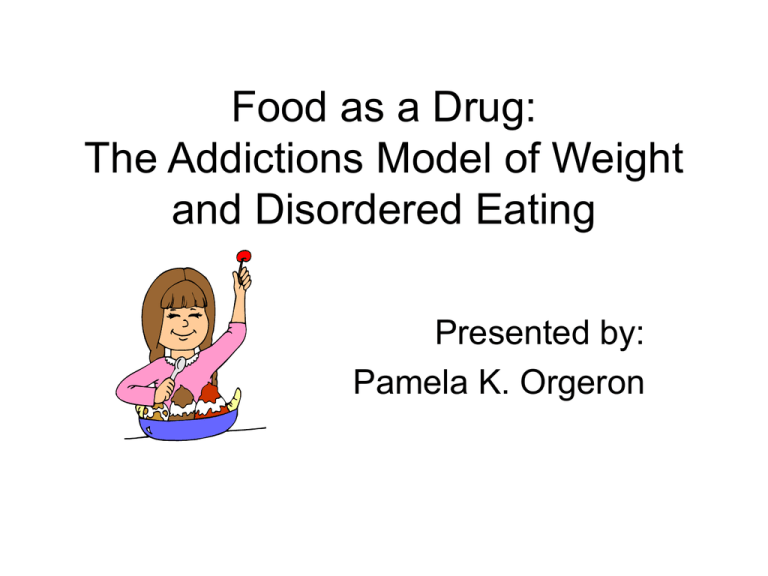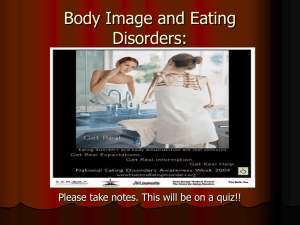here
advertisement

Food as a Drug: The Addictions Model of Weight and Disordered Eating Presented by: Pamela K. Orgeron Topics Covered: • Food as a Drug • Food Addiction and Drug Addiction Similarities • Classifications of Eating Disorders • Etiology of Disordered Eating • Prevention of Disordered Eating. Food as a Drug Similar to alcohol with an alcoholic, food also may be an addictive agent in the life of an individual. Minirth, Meier, Hemfelt, and Sneed (1990, p. 60) give six-steps in the downward spiral of developing an addiction. Figure below depicts this process. When does eating become an addiction? “Enjoying good food and looking forward to an excellent meal is certainly not a bad thing, in fact it is part of a quality life. But if we find ourselves obsessively thinking about our next meal, eating faster than those around us, choosing certain places to go solely for the food, and placing ourselves at risk with extremes in weight, then our obsession with eating is dysfunctional and addictive and ultimately creates health and body image problems” (DeGoede, 1998, p. 65). Food Addiction & Drug Addiction Similarities • A formerly pleasurable activity becomes a must (Orford, 2001). • Strong cravings accompany the experience (Orford). • loss of control in spite of harm (Orford). • Dopamine deficiencies exist (Holden, 2001). • similar personality factors (e.g.: impulsiveness & low self-esteem • comorbidity (dual diagnosis) also common (Poston and Haddock, 2000). Disordered Eating • As defined by Thunberg (1992), disordered eating encompasses a continuum from single dieting to the clinical diagnosis of anorexia and bulimia. According to Scarano and Kalodner-Martin (1994), the continuum of eating disorders places “normal” eating at one end, bulimia at the opposite end, and subclinical forms of unhealthy, eating patterns fall intermittently on the continuum” ┌──────┬─────┬─────┬──────┐ nondieter “normal” dieter problem dieter subclinical eating disordered clinical eating disorders Classifications of Eating Disorders • anorexia nervosa • bulimia nervosa. Eating Disorders in Children • pica • rumination disorder • feeding disorder of infancy or early childhood. (From DSM-IV-TR) ED-NOS • • • • • • • binge-eating disorder muscle dysmorphia (bigorexia) night-eating syndrome nocturnal sleep-related eating disorder Gourmand syndrome Prader-Willi syndrome cyclic vomiting syndrome. (Binge-eating disorder information from DSM-IV-TR. Other disorders from Anorexia Nervosa and Related Eating Disorders, Inc., 2002) Anorexia Nervosa • symptoms – refuse to maintain 85% normal body weight – excessive fear of weight gain, even though underweight – body weight & shape disturbances and inaccurate self perceptions – amenorrhea. • two subtypes – restricting type—starve bodies – binge-eating/purging type. Bulimia Nervosa • symptoms – recurrent episodes of binge eating – recurrent use of vomiting, laxatives, fasting, exercise, etc. – Binges & compensatory behaviors occur at least twice weekly for 3 consecutive months. • two subtypes – purging type—vomiting, laxatives, etc. – nonpurging type—fasting or exercise. Pica • primary feature: eating one or more nonnutritive substances persistently for a period of at least 1 month. • Substances vary with age: – infants & younger children—paint, plaster, string, hair – older children—animal droppings, sand, insects, leaves, pebbles – teenagers & adults—clay or soil. Rumination Disorder • repeatedly regurgitating & rechewing food. • Behavior exists for a period of at least 1 month following normal functioning period. • not attributed to esophageal reflux or other medical condition. Feeding Disorder of Infancy or Early Childhood • onset before the age of 6 years • persistently failing to eat adequately • significant failure to gain weight or significant weight loss over a period of at least 1 month • not attributable to medical condition • not attributable to another mental disorder or by lack of available food. Binge-eating Disorder • recurrent episodes of binge eating. • Binges are associated with at least 3 of the following: – eating faster than usual – eating beyond fullness – eating large portions when not hungry – eating privately from embarrassment – depression, guilt, etc. after overeating. • Binge creates marked distress. • occurs at least 2 days per week for 6 months. • Symptoms do not meet anorexia/bulimia criteria. Muscle Dysmorphia (Bigorexia) • opposite of anorexia • obsess about being too thin when they may be big in reality • abuse exercise & steroids to build what they feel are inadequate muscles. Night-eating Syndrome • little/no appetite at breakfast. • More than ½ of daily food intake occurs after dinner but before breakfast. • persisted for minimum 2 months • produces guilt & shame • causes sleep disturbances. Nocturnal Sleep-Related Eating Disorder • more of a sleep disorder. • People have episodes of eating in a state between awake and asleep. • unaware of eating, do not remember eating the next morning, & may eat unusual combinations of food or non-food items, such as soap they have sliced like they slice cheese. Gourmand Syndrome • preoccupation with fine food, including its purchase, preparation, presentation, and consumption. • Injury to right side of brain is believed to cause disorder. • rare: only 34 reported cases in medical literature. Prader-Willi Syndrome • cause: genetic defect (physiological brakes controlling appetite and hunger are defective) • may be misdiagnosed as bulimia (Symptoms here are physiological where with bulimia symptoms are psychosomatic.). • Mental retardation, behavior problems, and speech & muscle problems may exist with syndrome. Cyclic Vomiting Syndrome • diagnosed in children 2 to 16 yrs. old • frequent vomiting 10 or more times per hour. • Episodes may last from a few hours to several days. • other symptoms: stomach pains, nausea, & headaches • cause: unknown. Commonly asked: • Is obesity an eating disorder? (Comer, 2001) – Obesity alone is not sufficient evidence to diagnose an eating disorder. – Multiple factors, including genetic and biological factors, contribute to the obesity problem in society. – Overlapping patterns do exist between obesity, anorexia, and bulimia. Overlapping Patterns Between Obesity, Anorexia, and Bulimia (From Comer, 2001, p. 327) Etiology of Disordered Eating • • • • sociocultural factors individual factors family factors biological factors. Sociocultural Factors • messages from the media • prejudice against obesity. Individual Factors • personal history of dieting • using food as a drug (similar to a person abusing alcohol) • poor body image. Family Factors • prior emotional, sexual, or physical abuse in the family • dysfunctional parenting – “clean plate” club – “you must eat” syndrome – using food for comfort, as rewards or as part of celebration rituals – overeating to please others. Biological Factors • variations in the chemical sequence of the agouti-related protein (AGRP) gene that helps regulate hunger. The AGRP gene reduces the activity of melanocortin-4 receptor in the brain (National Alliance for the Mentally Ill, 2001). • relatives of persons with eating disorders 6 times more prone to develop the same disorder (Comer, 2001) • low levels of serotonin activity (Comer) • weight set point theory (Thompson, 2001). Prevention of Disordered Eating • primary prevention – prevents eating disorders before they start. • secondary prevention – keeps those in early stages from progressing – involves knowing the “warning signs”. • tertiary prevention – diagnosis & treatment of persons with full-blown eating disorders. Basic Principles of Prevention (Minirth, Meier, Hemfelt, Sneed, & Hawkins, 1990) • Do – Use commonsense in making food selections. – Learn about problems related to food & eating. – Use behavioral incentives other than food. NEVER use food as a reward. – Stay physically active. Find an exercise you enjoy. – Maintain a balanced diet with more fiber & less fat. – Have a support group. – Use discipline in moderation. Avoid extremes. • Don’t – Never base self-worth on looks. The Role of the Educator (From Renfrew Center, 2002) • Teach students about eating disorders. • Plan activities during Eating Disorders Awareness Week scheduled in February every year. • Understand the role of the media. • Start peer support groups. • Set an example. • Confront students with suspected eating disorders. Confronting Students with Suspected Eating Disorders • Confront privately initially. • Allow adequate time to avoid rushing & using the wrong words. • Point out specific observations arousing your concern. • Communicate compassion & concern throughout the confrontation. • Do not diagnose or become the student’s therapist. • Avoid arguing. • Focus on the student’s health, not appearance. • Know about community resources where help is available. (From National Eating Disorders Association, 2002) Do diets work? • No, diets have a 95% failure rate. In other words, 95% of those persons who loose weight, gain it back plus more. What is the answer to overcoming any eating problem? • Dominant Themes Reflected in Research: – permanent change--maintaining a permanently healthy lifestyle – on-demand eating--eating what you want whenever you are physically hungry and stopping when you are full. Bibliography American Psychiatric Association (2000). Diagnostic and statistical manual of mental disorders (4th ed., Text Rev.). Washington, DC: Author. Anorexia Nervosa and Related Eating Disorder, Inc (2002). Home page. [On-line]. Available: http://www.anred.com/ Comer, R. J. (2001). Abnormal psychology (4th ed.). New York: Worth. DeGoede, D. L. (1998). Belief therapy: A guide to enhancing everyday life. Lake Elsinore, CA: E. D. L. Holden, C. (2001). ‘Behavioral’ addictions: Do they exist? Science, 294, 980-982. Minirth, F. B. , Meier, P. D., Hemfelt, R., Sneed, S., & Hawkins, D. (1990). Love hunger. Nashville: Thomas Nelson. Bibliography continued National Eating Disorders Association (2002). Educators: Understanding your role. [On-line]. Available: http://www.edap.org/p.asp?WebPage_ID=286&Profile_ID=41167 National Eating Disorders Association (2002). Home page. [Online]. Available: http://www.edap.org/p.asp?WebPage_ID=337 National Alliance for the Mentally Ill (2001). Eating disorders news item: Variation in gene that regulates food intake found in people with anorexia. Retrieved through http://www.nami.org/ (Article unavailable on-line now). Orford, J. (2001). Addiction as excessive appetite. Addiction, 96, 15-31. Poston, W. S. C., II, & Haddock, C. K. (2000). Food as a drug. New York: Haworth. Bibliography continued Renfrew Center Foundation (2002). Home page. [On-line]. Available: http://www.renfrew.org/ Renfrew Center (2002). How educators can make a difference in schools. [On-line]. Available: http://www.renfrewcenter.com/forschools/index.asp Scarano, G. M., & Kalodner-Martin, C. R. (1994). A description of the continuum of eating disorders: Implications for intervention and research. Journal of Counseling and Development, 72, 356-361. Thompson, c. (2001). Set point. Retrieved January 28, 2002 from http://www.mirror-mirror.org/set.htm Thunberg, K. C. (1992). The Relationship Between Sexual Abuse and Eating Problems (Doctoral dissertation, Hofstra University, 1992). Dissertation Abstracts International, 53 (03), 762A. THE END








